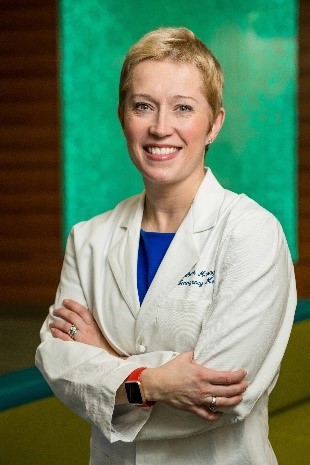‘Whatever Comes Our Way, I Know We Are Ready for It’

Elizabeth Murray, DO, FAAP
May 14,2020
I’ve heard some call it “Kawa-shocky,” referring to the recently identified syndrome that has started to cause severe illness in children in the U.S., especially in New York.
This syndrome combines aspects of two very well-described illnesses, Kawasaki Disease and Toxic Shock Syndrome. The concern here is that some are also positive for COVID-19 antibodies, despite having had none of the common COVID-19 symptoms.
As soon as we started to learn about COVID-19, the mantra was “at least children do not seem to become severely ill.” How unusual is that? Influenza, respiratory syncytial virus, and so many other germs often impact the young as severely as they impact the elderly. Now, we don’t know.
Maybe this germ is again presenting an entirely new set of challenges for us to conquer? What I do know is that we are ready to face this challenge too.
As a pediatric emergency medicine physician working at a large academic center in Rochester, N.Y., I have been struck by the “stillness” of our Peds ED in recent weeks.
My community did it! We flattened our curve. The number of new cases throughout the state is starting to come down. Our overall patient volumes have dropped significantly too.
Quarantining to prevent the spread of the coronavirus also prevents the spread of common colds and other common childhood infections. Organized sports have been canceled, so there are a lot fewer sports-related injuries, and fewer people are in cars or doing anything outside their home, so injuries from accidents have decreased too.
However, now I feel a new sense of intensity as we learn more about this new potential COVID-19 side effect that is making children so very ill.
Whatever comes our way, I know we are ready for it in the emergency department because EDs have always been prepared to care for whatever comes through the door. Our front-line EMS colleagues are ready too.
Fear of exposure to COVID-19 patients should not deter anyone from seeking care in an emergency. We have had to change how we function in the emergency department, but only because we have added layers of safety.
We always have been prepared to care for a child with an immune system weak from cancer treatment at the same time as we care for a child in respiratory distress from bacterial pneumonia. It’s just that you can’t see the special ventilation system that pulls air out of a room so germs don’t spread; or the disinfecting cleaning that every surface and piece of equipment in every room receives after each use; or the checklists completed every day to test and ensure normal functioning of our resuscitation equipment.
Those normal procedures were invisible to most patients. All those masks and gowns and goggles and face shields used to live in a storage closet and would come out from time to time when we cared for a patient with whooping cough or tuberculosis.
Now, they are the new extra layer of protection that you will see no matter what concern brings you to the emergency department. And that’s different, but it’s OK because it’s what we need to do to continue to keep everyone safe.
Send in your COVID-19 pandemic story, and we may share it here and on our social media channels. https://bit.ly/2XVvJIu
*The views expressed in this article are those of the author, and not necessarily those of the American Academy of Pediatrics.
About the Author
Elizabeth Murray, DO, FAAP
Elizabeth Murray, DO, FAAP, is a pediatric emergency medicine doctor at Golisano Children’s Hospital at the University of Rochester Medical Center. She is a spokesperson for the AAP and an NCE planning committee member.